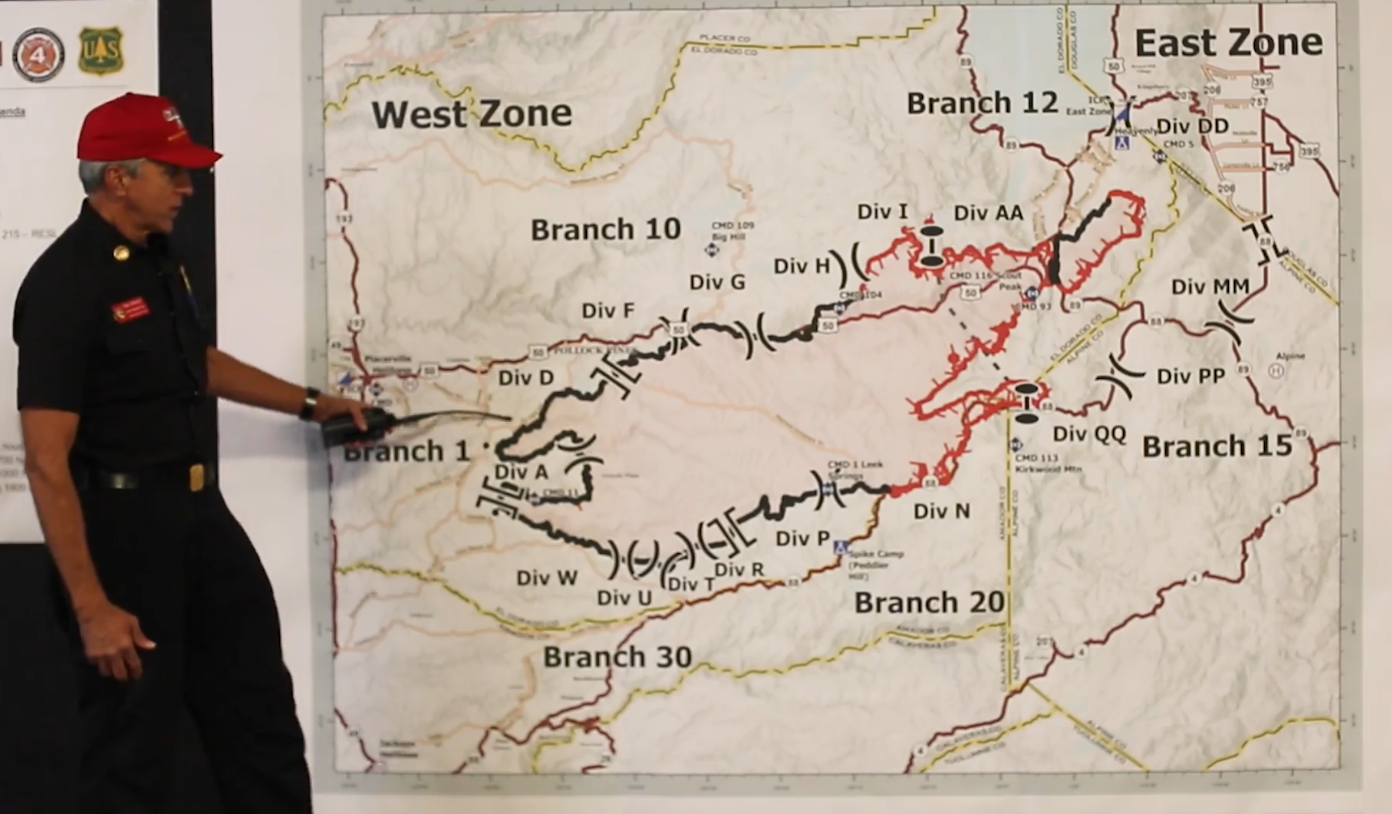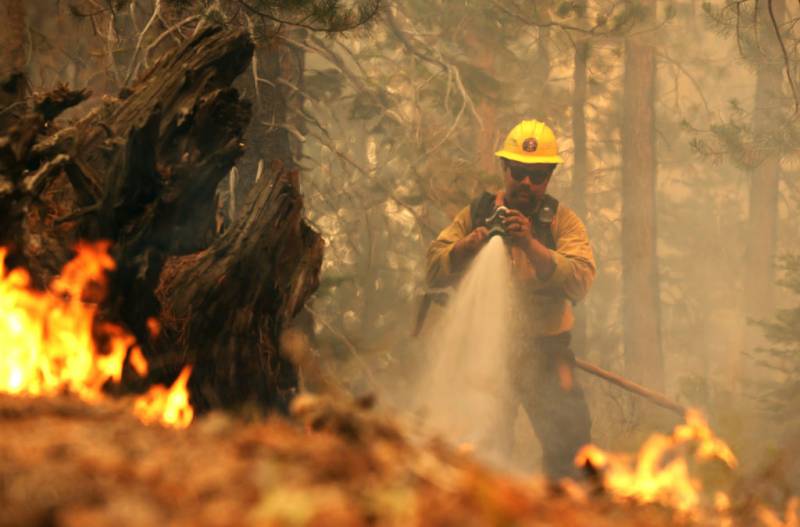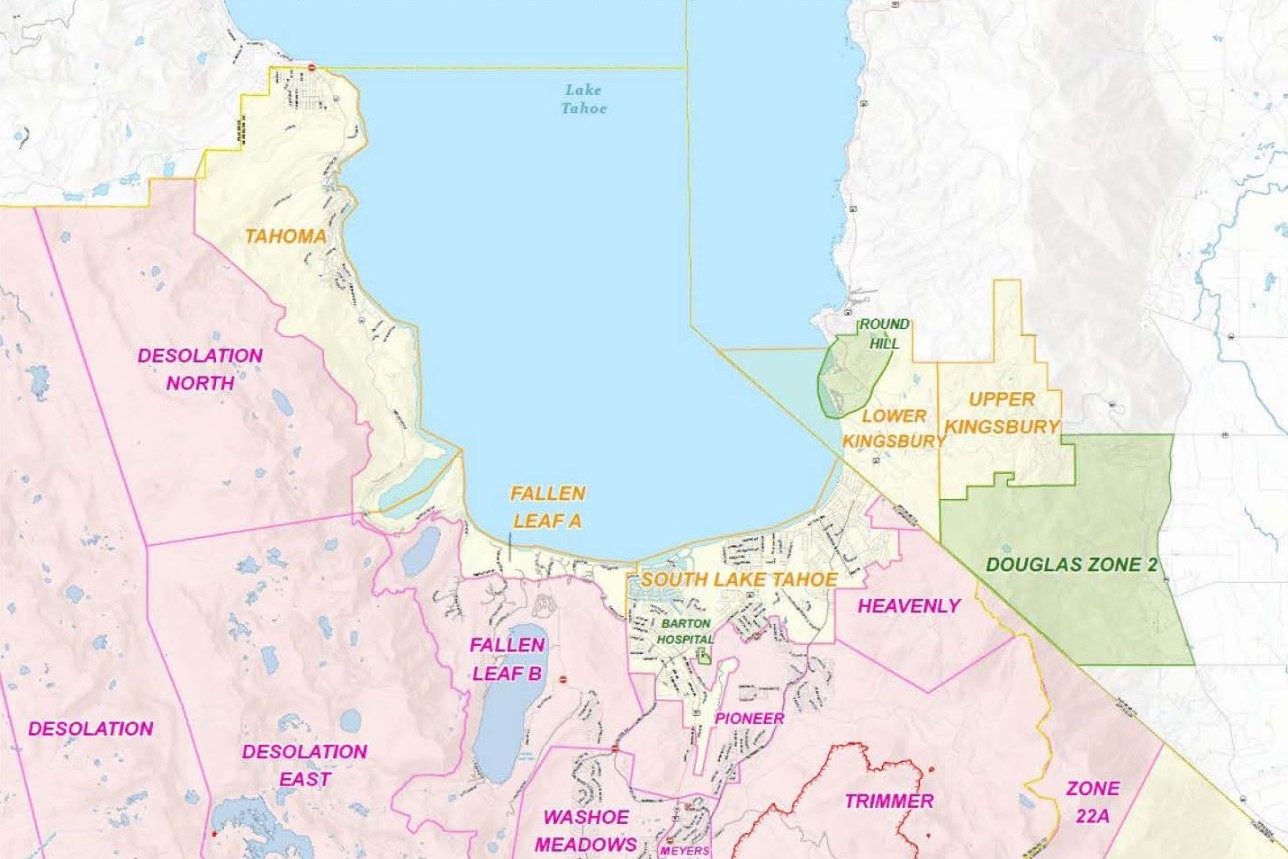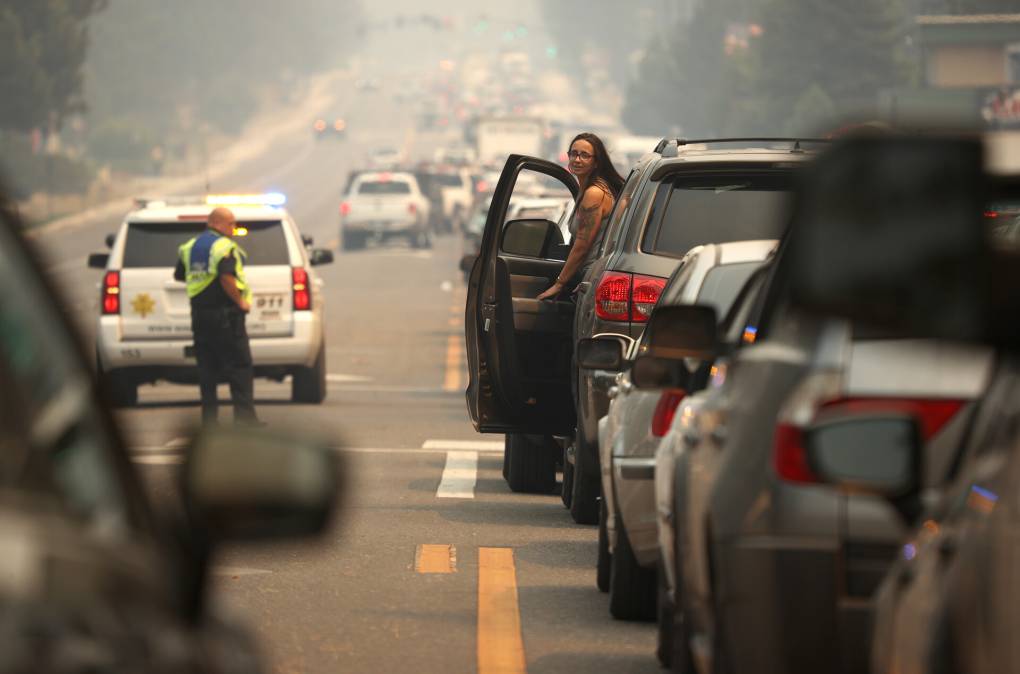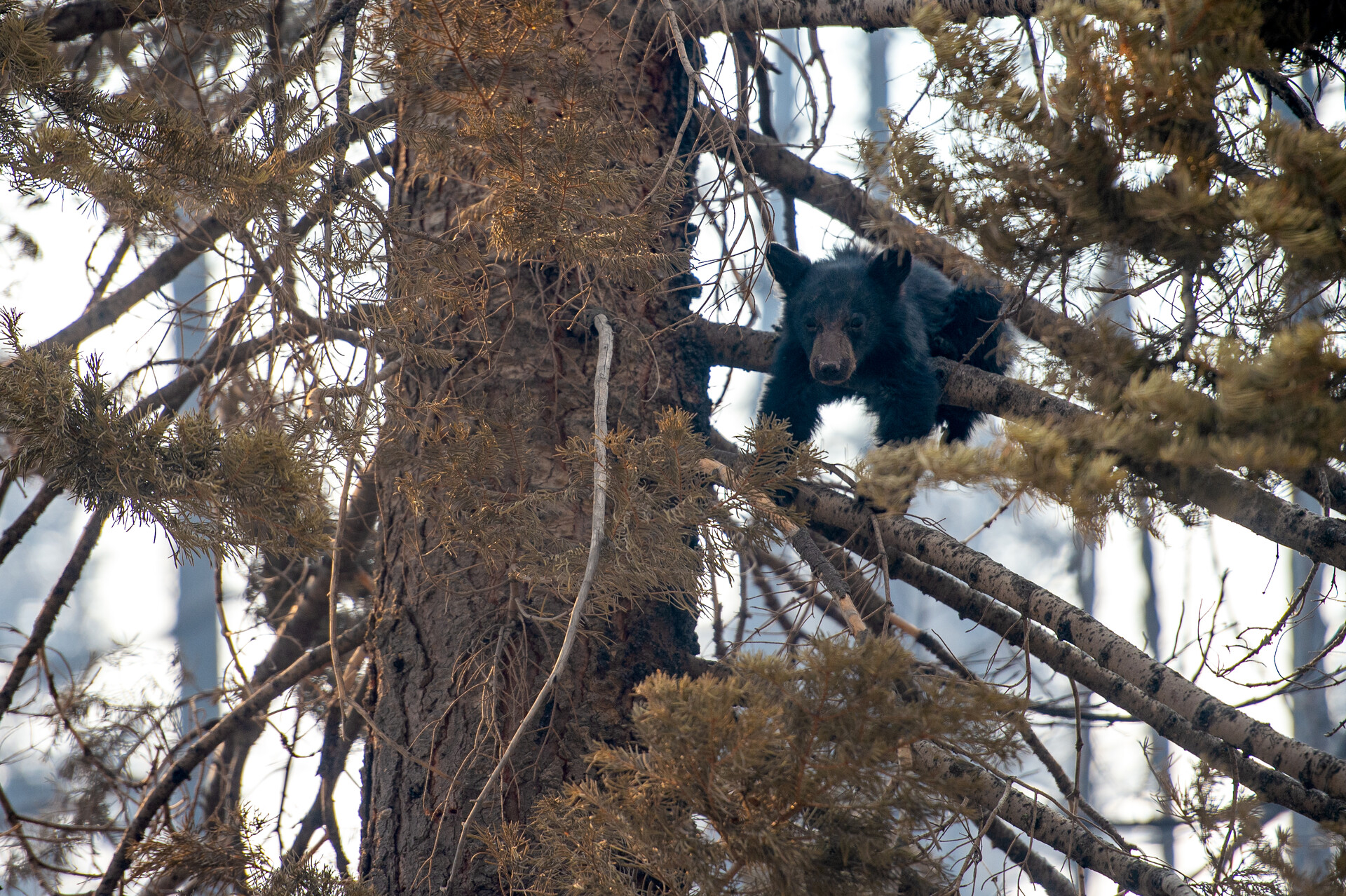“A lot of great work has gone on there,” said Cal Fire Operations Section Chief Tim Ernst in a Monday morning community briefing.
But on the morning of Labor Day, fire officials also signaled that conditions on Monday are a lot drier, which could make the work of containing what is left of the Caldor Fire much more difficult.
“I cannot emphasize how dry things are across this fire today. The humidity was very, very poor recovery last night,” said incident meteorologist Jim Dudley, who also added that the wind is blowing a lot more strongly than it did during the weekend.
With stronger winds comes a greater risk of embers flying out and widening the perimeter of the fire, Stephen Vollmer, fire analyst with Cal Fire, reminded fire crews Monday morning.
“We’ve got this thing, we’re wrapping our arms around it. We’re trying to take it down, but don’t get complacent on it,” he said. “Stay focused.”
For now, Highway 50 has reopened from the Nevada border to the South Lake Tahoe city limits to allow residents back in.
“People are really excited to get back into town,” said Mayor of South Lake Tahoe Tamara Wallace. She was quick to point out that the repopulation effort does not include all of El Dorado County and that there are many other communities still under an evacuation order.
“It’s … a testament to the firefighters and their amazing work that we are able to get back into our homes and all our homes are safe,” said Wallace, who for the moment plans to hold off for a few days until she returns to her own home in the city.
“There’s limited services,” she explained, pointing to the fact that, as of Monday morning, only one grocery store in the entire city had reopened.
Both Wallace and Cal Fire recommend that residents who are allowed to return to their homes first stock up on groceries, gas and other essential supplies before making the trip back. This also goes for folks who don’t live full-time in South Lake Tahoe but have a cabin or property in the area and want to check up on it.
Once a fire has burned through an area, many dangers remain: Damage to buildings can make them unstable; debris and downed trees can block roads; and downed utility lines pose serious electrical and other hazards. Fire officials also warn that the risk of flooding remains high for weeks and months after a wildfire, due to the amount of destroyed vegetation that once stabilized the soil.
Updated 10 a.m. Saturday
As of Saturday morning, Cal Fire AEU reported a continued decrease in fire behavior “thanks to a slight rise in humidity levels and decrease in temperatures.” Ongoing inspections for damage continue, but Cal Fire said 75% of structures were assessed. The fire is still most active on the south side of Echo Lake.
The smoke outlook for the Tahoe area is expected to be between moderate to unhealthy throughout the day with some light winds predicted to provide some relief. The temporary closure of all national forests in California is still in effect.
Updated 5:30 p.m. Friday
As fire crews manage the seemingly insurmountable feat of beating back the Caldor Fire from South Lake Tahoe, one question has been repeatedly aired by the public: When will people be allowed back?
The prospects are “looking good” for repopulating South Lake Tahoe, said U.S. Forest Service Operations Sections Chief Jake Cagle, but it depends on the weather and the efforts of hundreds of people — so officially, there’s no answer yet.
Still, Cagle said, “we’re getting close.”
South Lake Tahoe Fire Chief Clive Savacool said he and his fellow firefighters have been evacuated from their homes as well, “so we can empathize with you.”
Savacool thanked South Lake Tahoe citizens for pushing for more information, and said, “I wanted to assure you we’re going to get you home as soon as we can, as soon as the fire is safe. … It’s also our position to be your voice.”
The Caldor Fire has burned 212,907 acres as of Friday evening, and is 29% contained.
Repopulating areas that have been evacuated was on the minds of most fire officials at Friday evening’s community meeting, as they downgraded various areas from evacuation orders — which mandate evacuations — to warnings, which merely caution them.
Areas downgraded Friday afternoon include:
- South Sly Park: South of Starkes Grade Road, north of Sly Park Creek, east of Pleasant Valley Road up to and including the Diamond Garnet subdivision.
- Grizzly Flats West: East of Highway E16, west of Steely Ridge Road, south of the North Fork of the Cosumnes River and north of the Middle Fork of the Cosumnes River.
- Happy Valley: All properties accessed from Happy Valley Road.
Other fronts of the fire showed signs of fire crews finding success, including Christmas Valley, with fire officials saying “everything looks good” there, and Sierra Springs and the Lower Pines area both being downgraded to evacuation warnings, from orders.
Savacool had one more thought to reassure South Lake Tahoe citizens: We’re making sure the bears aren’t rummaging around your homes.
“We’ve gotten a lot of calls and concerns about the bears in town,” Savacool said Friday evening. He said law enforcement is “patrolling 24/7 to make sure your homes are safe, to scare off the bears, so your homes are protected.”
Make sure to check for full and up-to-date evacuation orders and warnings with Cal Fire.
Updated 2 p.m. Friday
The Caldor Fire has so far been successfully steered from South Lake Tahoe thanks to a break in weather conditions, defensive fire prevention and a continuous push from fire crews, officials said Friday.
Still, the fire has encroached on nearby areas, like Christmas Valley, and fire officials said the battle is far from over.
In a Friday afternoon community briefing, Anthony Scardina, deputy regional forester with the United States Forest Service, said a lot of the day’s success came from defensive field treatments like forest thinning and prescribed burns.
“There were conditions where there were 150-foot flame lengths, and when they hit, those field treatments worked, bringing them down to 20-foot flame lengths,” Scardina said.
“But we’re still not out of the woods,” he said. “We’re having some success, but there’s still a lot of fire on the landscape. And weather conditions can change pretty quickly, as you’ve seen.”
Some evacuation orders were downgraded to evacuation warnings as of 2 p.m. Friday afternoon, including:
- The area south of Pleasant Valley between Bucks Bar Road and Newtown Road
- East of Bucks Bar Road
- The areas of Gopher Hole Road and Moon-Shadow
- The area just south of U.S. Highway 50, north of Starkes Grade Road
- East of Snows Road
- West of Fresh Pond
The successful field treatments that aided fire efforts this week were the result of 10 years of fire prevention, Scardina said, and that’s work that needs to be ongoing.
“We have forest conditions that are overstocked. They’re too dense, and you combine that with a series of years of drought, and combine that with some of the warming temperatures we’ve seen,” he said, “with those three elements we have to continue working on them.”
Updated 9 a.m. Friday
Cal Fire expressed cautious optimism this morning, after another night of more favorable weather conditions allowed them to inch up containment on the Caldor Fire to 29%.
“I’ll sum everything up with the incident with the words ‘cautiously optimistic,'” Cal Fire Section Chief Tim Ernst said at the Friday morning briefing. “The humidities came in again last night, and fortunately we’ve had no significant fire runs through the entire shift yesterday. So we’ve definitely turned that corner.”
Ernst credited the consistent hard work of fire crews for saving thousands of homes and countless acres of forest. More than 4,400 firefighters are currently on the ground and in the air fighting the blaze.
Since first erupting on Aug. 14, the massive blaze has destroyed 661 homes and devoured nearly 213,000 acres, while continuing to threaten some 32,000 other structures.
While overall conditions are still dry, firefighters are taking advantage of the marginally improved humidity and reduced winds to secure key areas, like those along the Highway 50 corridor and near the Heavenly Mountain Resort.
